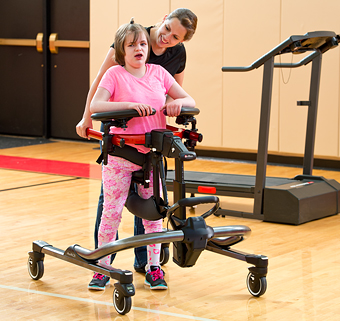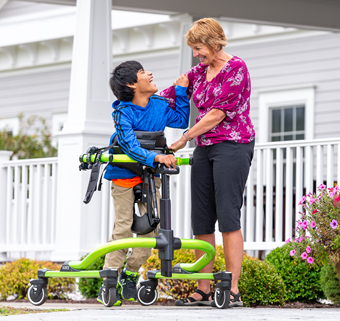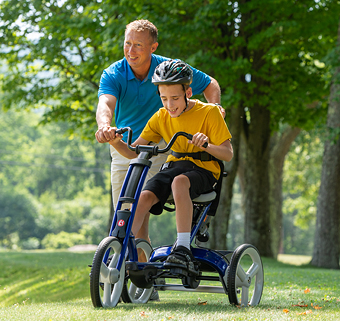 As school-based therapists we address gross motor and mobility opportunities for students, including transfers, walking, Physical Education, fitness, and gross motor activity participation. The school is a naturally supportive setting for improving gross motor participation for children of all abilities, and functional mobility plays an important role in learning. This article focuses on children with medical complexity (CMC) and improving their success in their educational program and into adulthood. Children with medical complexity are defined as having high health care needs, one or more chronic conditions, and often require medical technology and significant environmental modifications (Cohen, 2011). Typically, children in this category are functioning at Gross Motor Functioning Classification System (GMFCS) Level IV or V (CanChild).
As school-based therapists we address gross motor and mobility opportunities for students, including transfers, walking, Physical Education, fitness, and gross motor activity participation. The school is a naturally supportive setting for improving gross motor participation for children of all abilities, and functional mobility plays an important role in learning. This article focuses on children with medical complexity (CMC) and improving their success in their educational program and into adulthood. Children with medical complexity are defined as having high health care needs, one or more chronic conditions, and often require medical technology and significant environmental modifications (Cohen, 2011). Typically, children in this category are functioning at Gross Motor Functioning Classification System (GMFCS) Level IV or V (CanChild).
Exercise and Fitness for CMC: A Research Review
The World Health Organization (WHO) defines physical activity as “any bodily movement produced by skeletal muscles that requires energy expenditure. Physical activity refers to all movement including during leisure time, for transport to get to and from places, or as part of a person's work (WHO Fact Sheet).” Children with medical complexity who are functioning at a GMFCS Level IV or V will need postural support, physical accommodations or adaptations and therapeutic interventions to participate in functional mobility and physical activity in any setting, including school.
Because of difficulty with mobility and health complications, children with medical complexity often have impaired strength and cardio-pulmonary capacity (Verschuren, 2016), and impaired bone mineral density. Fitness activities to decrease sedentary behaviors along with increased time participating in gross motor activities can be beneficial for these children and adults. In a systematic review by Liquori et al, (2022), adults with cerebral palsy (CP) in all age groups were found to have a higher prevalence of osteoporosis than age-matched peers. Interventions that included weightlifting, calisthenics, cycling, and high intensity walking and exercise produced the largest Osteogenic Index (OI). OI is a measure of the effectiveness of exercise protocols which estimates bone formation according to exercise intensity. OI improvements were found with daily treatment with a vibrating platform for six months, or with a whole-body vibration training program four times per week for five months. They also found that a multimodal program several times per week for six months in children with GMFCS levels II to IV produced an improvement in the OI. This study found that there is evidence that weight bearing activities do promote bone mineral density in individuals with cerebral palsy, but current interventions may be underdosed and are impacted by the severity of gross motor impairment. Therefore, more creative, and innovative movement programs should be designed for individuals classified GMFCS level V to promote skeletal health and prevent secondary conditions. (Liquori et al, 2022)
In a study on the effects of high-intensity interval training in fitness and health on youth with disabilities, Zwinkels et. al (2019) found improvements in aerobic and anaerobic performance after two high interval training sessions per week for eight weeks. As school-based PT’s, we can translate this evidence into practice by implementing a daily exercise program for our students with medical complexity. While children and adults with medical complexity are not able to move, exercise or train in high intensity intervals as easily or effectively as others who function at GMFCS I, II, or III, with adaptations, modifications and supports, we can provide opportunities to move, recreate, strengthen, reduce sedentary behaviors, and improve participation in gross motor activities.
The importance of replacing sedentary behavior with physical activity for people with cerebral palsy is highlighted in recommendations from Verschuren, et al (2016). For individuals with significant physical limitations, increasing baseline physical activity can be an effective starting point. Time spent in weight bearing or transitioning between sitting and standing can be a light intensity starting option to increase energy expenditure. Short episodes of activity are appropriate for people who were previously inactive, and gradual increases in activity level should be carefully monitored for tolerance. (Verschuren et al, 2016)
As school based physical therapists, there are several pieces of adaptive equipment that can help children with medical complexity engage in movement activities, reducing sedentary behaviors and facilitating mobility and fitness opportunities.
Mobility Equipment to Support Exercise and Fitness

Children with medical complexity benefit from use of supportive walkers and gait trainers for upright mobility opportunities. The Rifton Dynamic Pacer provides
support options including a multi-position saddle to facilitate pelvic positioning during stepping, as well as chest and arm prompts for upper body
postural support. This gait trainer provides opportunities for dynamic weight bearing and weight shifting. For individuals who need additional support with transfers, the E-Pacer or the Rifton TRAM provide motorized support for the sit-to-stand transition. Once standing, the individual can practice weight bearing with the ability to measure and increase the percentage of weight bearing over time. For students who have better function of their upper extremities, the Rifton Mobile Stander can be used for weight bearing, independent mobility, and an upper body resistance activity for both strength and endurance.
Research supports the use of walkers and gait trainers for children with disabilities. Rodriguez-Costa et al (2021) found that use of a support walker for children with cerebral palsy had key benefits including improved emotional wellbeing (increased happiness), physical wellbeing (including strength and balance), and social enjoyment (promoting improved participation). George et al (2020) surveyed providers in the UK about the use and perception of support walkers for children with disabilities. Increased physical activity time, enjoyment and increased participation were the most frequently reported benefits. Paleg and Livingstone (2015) conducted a systematic review on the outcomes of gait trainer use in home and school settings for children with motor impairments. They found descriptive evidence related to increasing walking distance, improved bowel function, increased bone mineral density and positive impacts on participation. However, because the evidence was primarily descriptive, further research is needed.
 An option for exercise and fitness for children and adults with medical complexity is the Rifton Adaptive Tricycle. This tricycle has an adjustable seat and offers trunk, lateral and headrest supports. The push handle or guide bar offer options for assistance with propulsion of the tricycle, and the new model tricycle includes a variable pedal resistance which can increase the challenge for an individual who is able to actively pedal. Children and adults with medical complexity can gain a variety of benefits from adaptive cycling, including leg strengthening, posture and balance practice, range of motion, reciprocal alternating leg motion, practicing visual skills needed for steering and improved participation and social interactions. Armstrong, et al (2019), completed a systematic review of cycling interventions in children and adolescents with cerebral palsy. They found preliminary evidence to support improved gross motor function in non-ambulant children with cerebral palsy but concluded that more high-quality research is needed to determine optimal parameters for improved function.
An option for exercise and fitness for children and adults with medical complexity is the Rifton Adaptive Tricycle. This tricycle has an adjustable seat and offers trunk, lateral and headrest supports. The push handle or guide bar offer options for assistance with propulsion of the tricycle, and the new model tricycle includes a variable pedal resistance which can increase the challenge for an individual who is able to actively pedal. Children and adults with medical complexity can gain a variety of benefits from adaptive cycling, including leg strengthening, posture and balance practice, range of motion, reciprocal alternating leg motion, practicing visual skills needed for steering and improved participation and social interactions. Armstrong, et al (2019), completed a systematic review of cycling interventions in children and adolescents with cerebral palsy. They found preliminary evidence to support improved gross motor function in non-ambulant children with cerebral palsy but concluded that more high-quality research is needed to determine optimal parameters for improved function.
Monitoring for pain and comfort
As with all equipment and movement recommendations, in order to gauge tolerance to activities, a variety of pain scales should be used including the Individualized Numeric Rating Scale (INRS) (Solodiuk & Curley, 2003) and the Face, Legs, Activity, Cry, Console Scale (FLACC) (Merkel et al, 1997). A copy of these scales should be kept in the areas where the children/young adults are seen to help staff identify painful behaviors and know when to stop or modify an activity based on these responses. Some children can also use a switch to alert staff to assist them in changing positions. Also watch for color changes in the skin to identify cardiopulmonary fatigue.
Measuring Exercise Tolerance and Creating Appropriate Goals
Children and teens with medical complexity can make very small, but very functional changes measured with SMART (Specific, Measurable, Achievable, Relevant, Time-bound) or GAS (Goal-Attainment Scaling) style goals using adapted equipment. Some of the gains will be in the level of caregiver assistance (i.e. the caregiver may be providing less support or assistance). Some ideas for goals using Rifton gait trainers and adaptive tricycles include:
Sample SMART goals:
Given the postural support of the Dynamic Pacer, verbal cues, and assistance to steer the gait trainer on level surfaces, the student will take one hundred steps to transition between classrooms to improve mobility at school.
Given the postural support of the Pacer gait trainer, verbal cues, and assistance to steer the gait trainer, the student will walk for ten minutes on the outdoor playground at recess to improve participation with peers.
When positioned in the E-Pacer with postural support and after use of the motor to transition from sitting to standing, the student will take ten active steps, in order to improve active participation in mobility at school.
Given the postural support of the Adaptive Tricycle and assistance to steer, the student will actively pedal for fifteen minutes across a level surface in Adapted Physical Education class in order to improve participation with peers.
Given the postural support of the Mobile Stander, verbal cues and practice, the student will successfully navigate 5/5 obstacles in the classroom or in the gym, in order to improve independent mobility at school.
Sample GAS goal:
Given full postural support of the Adaptive Tricycle (trunk support, laterals, and chest harness), the student will actively engage in pedaling for 5 minutes with moderate assistance for propelling and steering during outdoor adapted physical education with peers.
|
Attainment Level
|
Score
|
Description
|
|
Baseline
|
-2
|
Given full postural support of the Adaptive Tricycle (trunk support, laterals, and chest harness), the student will actively engage in pedaling for 5 minutes with moderate assistance for propelling and steering during outdoor adapted physical education with peers.
|
|
Less than expected outcome
|
-1
|
10 minutes
|
|
Expected outcome
|
0
|
15 minutes
|
|
Greater than expected outcome
|
1
|
20 minutes
|
|
Much greater than expected outcome
|
2
|
25 minutes
|
We hope that this series has been helpful. When considering the best options for children with medical complexity, it is important to remember the “F-words” from Rosenbaum, et al (2012): Function, Family, Fitness, Friends, Fun and Future. Adaptive equipment is the key to modifying activities and enabling participation and movement opportunities.
Back to Top